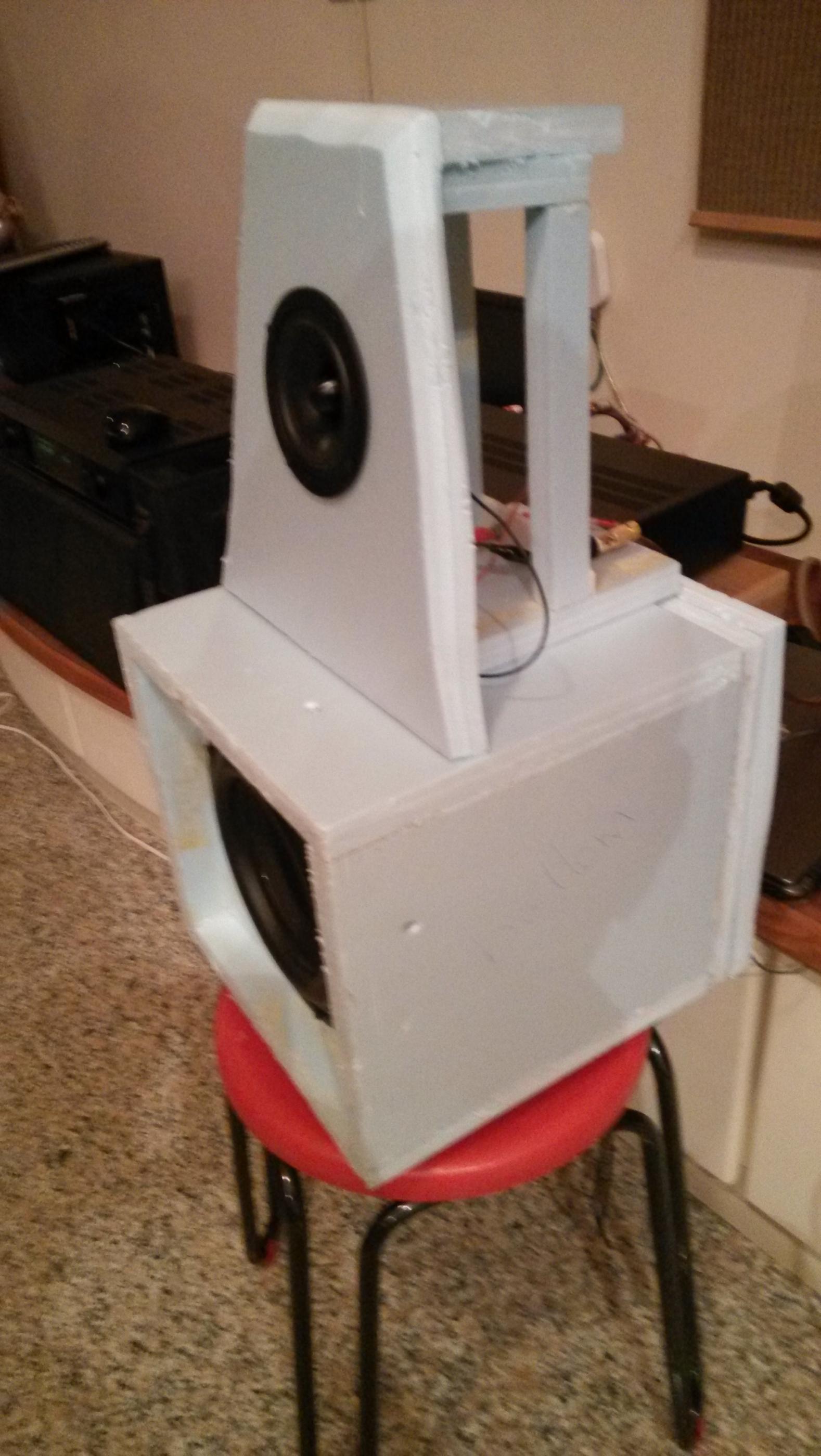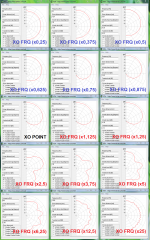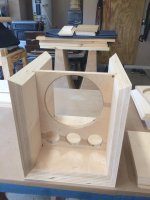really nice - can a budget version be done with 4fe32?
4FE32 is no budget driver, sounds very good from what I see in charts. A bit of a waste of sensitivity though unless you were planning on using more sensitive woofers. You could use a K12 as your “woofer” and then the 4FE32 is perfect as a top. What not a K-FAST? That would sound really dynamic and be 91dB sensitive to boot.
Well, the OB version was not a success. I tried to make it work, but it just doesn't sound right.
I'll be following your footsteps and put the B80 in a dagger style enclosure .
Also, I'll forego the vented woofer and seal the box for the next try.
I guess I was trying to push too much in every direction, I went nowhere.
It's the beauty of DIY, I guess! 😉
I'll be following your footsteps and put the B80 in a dagger style enclosure .
Also, I'll forego the vented woofer and seal the box for the next try.
I guess I was trying to push too much in every direction, I went nowhere.
It's the beauty of DIY, I guess! 😉
Yes, sealed makes a difference - if you are doing miniDSP, you can add Linkwitz transform to eek more bass out of the lower end. The lack of temporal coherence of bass reflex doesn't work. But most likely when it doesn't sound right, it may be integration issues on your crossover. On miniDSP do individual EQ's to get the textbook 1st order curve on each driver. Then integrate and see if overall curve is still flat. You may need delays to smooth it out and get phase flat. 1st order filters are actually more difficult to implement properly than higher order LR2. But the results are a very realistic sound and immediacy of transporting you back to the location of the recording.
It should work OB as well, but the back wall reflections could be ruining the whole transient perfect timing thing.

Your setup looks nice - it should work, so probably something off in the XO. Try to reduce the C-T-C spacing between the woofer and full range so that the sound appears to come from one source.
Is that 1in thick XPS foam insulation sheets?
It should work OB as well, but the back wall reflections could be ruining the whole transient perfect timing thing.
Your setup looks nice - it should work, so probably something off in the XO. Try to reduce the C-T-C spacing between the woofer and full range so that the sound appears to come from one source.
Is that 1in thick XPS foam insulation sheets?
Last edited:
It is 2cm XPS foam, more like 3/4".
I could play with them more, but there was something really fishy with the sound.
It was all garbled, no definition, no spatial cues. Nothing like my big OB setup. The magic of OB was not there with this smaller setup.
I will try again later, either trying to polish that 1st order XO, or just go back to the Harsch!
I could play with them more, but there was something really fishy with the sound.
It was all garbled, no definition, no spatial cues. Nothing like my big OB setup. The magic of OB was not there with this smaller setup.
I will try again later, either trying to polish that 1st order XO, or just go back to the Harsch!
...I could play with them more, but there was something really fishy with the sound.
It was all garbled, no definition, no spatial cues. Nothing like my big OB setup. The magic of OB was not there with this smaller setup.
I will try again later, either trying to polish that 1st order XO, or just go back to the Harsch!
Because it can mean alot maybe try turn it upside down as X does 🙂
Its right 1st order sums transient perfect in electric domain or with a coxial unit but when physical spacing is used that develop a rather complicated unsymmetrical looking summing polar and that's maybe the reason Dunlavy used WTW config instead of WT. Say the two summing drivers have needed bandwidth plus exactly same polar dispersion and time aligned plus spacing is set exactly 1/4 wave then below visual should show what happens summing 1st order. For HARSCH XO 1st 2nd and 3rd row below is nearly same looks but in 4th and 5th row it will look better and symmetrical follow the 0dB spin.
Attachments
Last edited:
I had the woofer at ear level, and FR higher up, I figured it would induce the same delay, plus, I placed the FR 5cm behind the woofer.
Things to try... but not today.
After living in grey rainy and 12C weather for 2 weeks, the sun came out with 18C, so I will be outside trying to make some vitamin D that my body desperately needs!
Things to try... but not today.
After living in grey rainy and 12C weather for 2 weeks, the sun came out with 18C, so I will be outside trying to make some vitamin D that my body desperately needs!
Are you using the B80 on top in the open baffle? If you have miniDSP driving probably best to use Harsch and put 4th order on the woofer at 600Hz and Bessel 1st order on B80 at 600Hz high Pass. You can flush mount both baffles delay is digital and needs to be 1.6ms. It should sound good of not great.
eh... you meant 2nd order on the B80, right?
The only thing is that I can't find the digital delay setup in miniDSP HD... I think they took it out, which is kind of strange.
I got PEQ, XO, Comp and FIR on the outputs, but no delay. I guess it could be done with FIR and RePhase, but that's more work.
My goal design-wise was to have a slanted baffle, so , maybe no need for a delay.
The only thing is that I can't find the digital delay setup in miniDSP HD... I think they took it out, which is kind of strange.
I got PEQ, XO, Comp and FIR on the outputs, but no delay. I guess it could be done with FIR and RePhase, but that's more work.
My goal design-wise was to have a slanted baffle, so , maybe no need for a delay.
Yes, sorry I meant 2nd order Bessel high pass. Digital delay is a key requirement and would be off for it to be removed. It’s ubsually in same screen as amplitude adjust. Which plugin are you using?
The plugin that came with the miniDSP HD...
oops... found it! I didn't know because it doesn't have a title to the adjust window... I needed to comb the user manual to find it.
so, 1.6ms eh? that's not much... are you sure our ears can hear "that fast"?
oops... found it! I didn't know because it doesn't have a title to the adjust window... I needed to comb the user manual to find it.
so, 1.6ms eh? that's not much... are you sure our ears can hear "that fast"?
Our ears can discern phase shifts corresponding to the distances in the folds of our outer ears. That’s how we get directionality from even 1 ear. The sound has different phase shifts depending on direction as if passes by the folds. Circa 1cm distances and at 342m/s that’s about 30microseconds. That’s how we get spatial imaging from stereo speakers. Minute microsecond phase shifts. I think delays in miniDSP are adjustable down to 10microsec. So 1600 microseconds is huge in terms delay.
Hi XRK,
Having made your great headphone amp, I had been searching for an upgrade to my existing infinite baffle speakers and just made a post in the Multiway speaker section, only to by chance finding this post in this section.
Infinite Baffle Standmount
While I built my originals they were quiet simple, but your design and speakers specified do seem a step up and the drive unit on page1 do seem available this side of the pond.
I appreciate it seems more a developers thread for those who know and experiment in such areas , but I have not been able to find any details of the cabinet and strut sizes or exactly what and how the Dagger TL baffle is made up ?
Again it seems you and others have tired various other drive units but assume you still stand by the units as on page 1.
If you can offer any clarity for a beginner like me it would be much appreciated though would equally accept if you feel its more a developers project than a straightforwards build.
Having made your great headphone amp, I had been searching for an upgrade to my existing infinite baffle speakers and just made a post in the Multiway speaker section, only to by chance finding this post in this section.
Infinite Baffle Standmount
While I built my originals they were quiet simple, but your design and speakers specified do seem a step up and the drive unit on page1 do seem available this side of the pond.
I appreciate it seems more a developers thread for those who know and experiment in such areas , but I have not been able to find any details of the cabinet and strut sizes or exactly what and how the Dagger TL baffle is made up ?
Again it seems you and others have tired various other drive units but assume you still stand by the units as on page 1.
If you can offer any clarity for a beginner like me it would be much appreciated though would equally accept if you feel its more a developers project than a straightforwards build.
Hi XRK,
Having made your great headphone amp, I had been searching for an upgrade to my existing infinite baffle speakers and just made a post in the Multiway speaker section, only to by chance finding this post in this section.
Infinite Baffle Standmount
While I built my originals they were quiet simple, but your design and speakers specified do seem a step up and the drive unit on page1 do seem available this side of the pond.
I appreciate it seems more a developers thread for those who know and experiment in such areas , but I have not been able to find any details of the cabinet and strut sizes or exactly what and how the Dagger TL baffle is made up ?
Again it seems you and others have tired various other drive units but assume you still stand by the units as on page 1.
If you can offer any clarity for a beginner like me it would be much appreciated though would equally accept if you feel its more a developers project than a straightforwards build.
Thanks for your interest. The drivers remain valid: 10F/8424 and RS225-8. The RS225 is unique in its price range and exhibits TS parameters and build quality of something maybe 3x price range.
Cabinet is simple prismatic box 10in wide x 18in tall x 12.5in deep (external dimensions) and 3/4in MDF of 18mm B.B. ply. A single window brace inside is sufficient. Line walls with eggcrate acoustic self adhesive foam sound insulation pads or 12mm felt. Add loose fiberglass stuffing inside. For Dagger make three triangles 12in tall x 6in wide base. Glue together to make 3 sided Dagger. Glue 6in edge x3 mouth to baffle. Stuff with Fiberglas progressively denser towards vertex. Make sure airtight so woofer doesn’t leak into midrange chamber. Or use 9n tall sport cones stuffed with fiberglass as shown a few posts ago. Internal volume of main box should be circa 24L or so. Volume of Dagger should be about 1.2L to 3L max. Baffle should have drivers as close together as possible but to allow room for window bracing and Dagger, about 7.5in CTC is about right. Woofer in top above mid tweet.
Amazon.com : Cintz 9" Orange Field Cone Markers, Set of 10 : Soccer Training Cones : Sports & Outdoors
That’s about it. If making out of XPS foam, brace as necessary (a lot more than if MDF or B.B. ply).
Last edited:
Thanks a lot XRK, so refreshing to find someone on the web willing to share and help folk.
Much appreciated.
Much appreciated.
\Thanks a lot XRK, so refreshing to find someone on the web willing to share and help folk.
Much appreciated.
No problem... Here is render to help visualize above description
That looks nice X!
DiyRicky:
Here's a pic of the brace I made from my version of these. The enclosure is just for the rs225. The walls are 50mm baltic birch, and the brace is 18mm.
Wow, 50mm BB walls! 😀
I might line the inside of my 3/4in BB with the automotive sound panel dampening sheets (sticky mass loaded black butyl rubber faced with foil), then add the 1in thick eggcrate foam sheets. These details seem to make a difference with lower HD in the end.
Wow, 50mm BB walls! 😀
I might line the inside of my 3/4in BB with the automotive sound panel dampening sheets (sticky mass loaded black butyl rubber faced with foil), then add the 1in thick eggcrate foam sheets. These details seem to make a difference with lower HD in the end.
Interesting, is this move inspired by a deficiency in your previous XPS foam build, or is it due to differences in the absorbent properties of BB vs foam?
I've seen Troels Gravesen recommend bitumen pads for lining the interior of some of his speakers (with felt on top). One thing he seems to keep mentioning is to glue them on with additional adhesive since the stuff they come with tends to weaken with time and cause them to fall off...
Another question, if one was to substitute the 10F for another driver, which of the TS parameters would you be most worried about matching? Or do you consider the 10F critical to the success of this speaker?
I definitely have some mild wall rattle that causes an exaggerated harmonic distortion reading at the lower registers. Gluing on a thin wood veneer with a pliable adhesive like I did for baffle helps a lot. For the BB cabinets, I am taking my cues from Bushmeister, when he built his point source horn cabinet, he used every trick in the book, including sorbothane sheets between the braces and the driver magnet, between baffle and braces, thick felt lining, etc. His distortion numbers, were without a doubt, heavily influenced by use of the superb SB23NRXS45-8 driver with remarkably low at deep bass frequencies while making 100dB at 1m. So, I will try some of the tricks that are easy to do.
If you want to swap the mid-tweet, no doubt the 10F/8424 is the king, but 10F/8414 would be pretty good too, or even TG9FD-08, or TC9FD. They are all "in-family" of having a smooth response, and proprietary pentacut cone for low resonances/breakup. You will just have to adjust level of padding of tweeter. I have had good luck with FF85WK too, but power handling on that driver is almost nil, and I like to play loud with a 95w amp at 50wrms 🙂 Almost any 2.5 to3.5 in full range, 8ohms impedance and able to handle a smaller 1L to 3L rear sealed chamber can work. As long as it is smooth and has a very little breakup. Sort of directs us to the SS/Vifa/Peerless family of 3.5in drivers. I think Fountek FR88EX can work well too. Hope that helps. In the end, having a mic to measure and adjust tweeter padding will give you the best performance.
If you want to swap the mid-tweet, no doubt the 10F/8424 is the king, but 10F/8414 would be pretty good too, or even TG9FD-08, or TC9FD. They are all "in-family" of having a smooth response, and proprietary pentacut cone for low resonances/breakup. You will just have to adjust level of padding of tweeter. I have had good luck with FF85WK too, but power handling on that driver is almost nil, and I like to play loud with a 95w amp at 50wrms 🙂 Almost any 2.5 to3.5 in full range, 8ohms impedance and able to handle a smaller 1L to 3L rear sealed chamber can work. As long as it is smooth and has a very little breakup. Sort of directs us to the SS/Vifa/Peerless family of 3.5in drivers. I think Fountek FR88EX can work well too. Hope that helps. In the end, having a mic to measure and adjust tweeter padding will give you the best performance.
Last edited:
- Home
- Loudspeakers
- Full Range
- 10F/8424 & RS225-8 FAST / WAW Ref Monitor

